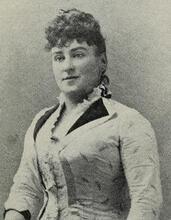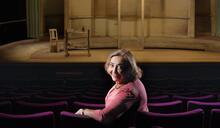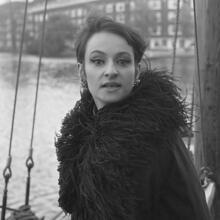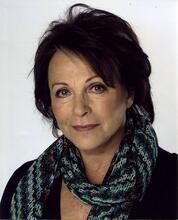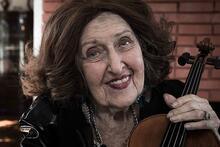Ida Kaminska
Ida Kaminska’s life adventures, extraordinary talent, astonishing vitality, and passionate devotion to theatrical art and the culture of the Nation of Yiddish make her one of the symbols of twentieth-century Polish Judaism. Ida Kaminska established more than one company; she directed several troupes, wrote two original plays, translated and adapted fifty-eight plays into Yiddish, directed sixty-five plays, and performed in one hundred and twenty-four. She was influenced by her mother, Esther Rachel, who was the founder of modern Yiddish theater and an influential actress. Ida Kaminska translated, adapted into Yiddish, produced, and performed the first-ever presentation of Berthold Brecht’s Mutter Courage in Poland. She was considered among the greatest actresses in Poland and one of the greatest tragic interpreters of her period.
In the first pages of her autobiography My Life, My Theater, Ida Kaminska writes of her mother Esther Rachel, termed “the Jewish Eleonora Duse,” that she was educated by three forces: “the poverty she saw with her clever eyes, the suffering with which her great heart empathised, the injustice against which she was able to rebel. All became components of Esther Rachel Kaminska.”
Introduction
Ida Kaminska, the woman who in these lines so skillfully sums up the profound popular and ethical roots of Yiddish theater; Ida Kaminska, inspired actress, impresario, director and translator, also had an extraordinary talent for mediation and diplomacy. Henryk Grynberg, a former actor in her company and a famous Polish Jewish writer, called her “Talleyrand in a skirt.”
Ida Kaminska was born on September 4, 1899, in the Teatral’naja Gostiniza, the Theater Hotel, in Odessa during one of her parents’ frequent tours. She died in exile in New York in 1980. Her life’s adventures, her extraordinary talent, her astonishing vitality, her passionate devotion to theatrical art and to the culture of the Nation of Yiddish make her one of the symbols of twentieth-century Polish Judaism.
Ida Kaminska established more than one company; she directed several troupes, often in the most dire conditions; wrote two original plays; translated and adapted into Yiddish fifty-eight plays, including many masterpieces of world theater; directed sixty-five plays and performed in one hundred and twenty-four. She translated, adapted into Yiddish, produced and performed the first-ever presentation of Berthold Brecht’s Mutter Courage in Poland. Kaminska was considered among the greatest actresses in Poland and one of the greatest tragic interpreters of her period. She was driven during her entire life by a dream: that of establishing a Yiddish repertory theater company composed of professionals, whose repertoire would extend from Shalom Aleichem to William Shakespeare.
Ida’s father, Abraham Isaac Kaminski (1867–1918), was an actor, a director, and a theatrical organizer. Born in Warsaw’s Jewish “slums” he dreamed of teaching Jews “to live better, to love beautiful and better things.” In 1913 Abraham Isaac purchased a theater in the center of Warsaw. Kaminski’s Theater, active until 1935, was one of the first attempts to create a professional Jewish theater th atalso staged international dramas.
Esther Rachel Kaminska
The most important figure in Ida Kaminska’s life was certainly her mother, Esther Rachel (Ester Rokhl in Yiddish) Kaminska (née Halperin). Esther Rachel was the founder of modern Yiddish theater, the person who “traced its entire future path.” In a period when Yiddish theater was dominated by shund, the cheap melodrama performed with loud cries and tears, Esther Rachel Kaminska was probably the first actress to propose a kind of introspective, measured acting and to imagine theatrical work not as based uniquely on the star but rather as the result of a team effort.
The entirely self-educated daughter of a poverty-stricken cantor in Porozowo, a (Yiddish) Small-town Jewish community in Eastern Europe.shtetl l in Grodno province, Esther Rachel made her debut in 1888 in her husband’s company. She was renowned for her performances in the melodramatic tragedies of Jacob Gordin (1853–1909) and was the perfect embodiment of Mirele Efros, the yidishe mame par excellence, which became a favourite part of hers and later of her daughter Ida. Called di mame, the Mother, by colleagues and by her audience, Esther Rachel was a person for whom, as her daughter Ida writes, “being a mother was not only a question of sentiments, but of all her behaviour and of her way of being.”
Esther Rachel’s maternal instinct had a direct impact on the success of the company. This success was vital to her: to earn enough to maintain the family and to earn enough to purchase and later support Abraham Isaac’s theater. Because of her love for the theatrical Muse, because of her devotion to an adoring audience and also because of love for her husband, Esther Rachel was prepared to endure months of wearisome tours (which included two exhausting but very well-paid tours to the United States, in 1908 and in 1909) and the continuous sorrow of having her children far away.
Ida’s Performance Career
Ida Kaminska’s first stage appearance, in 1904, was with her mother in David Pinski’s play The Mother. Jacob Gordin, the favorite playwright of the Yiddish stage, wrote many roles for children. From 1906 to 1911, Ida acted in Gordin’s The Nameless, Mirele Efros, The Kreutzer Sonata, and Without a Home.
In 1913 the young girl began acting in the family theater. Here she performed in several operettas of the classical Yiddish repertoire, especially those of Abraham Goldfaden. In 1916, the year that marked her “adult debut,” Ida Kaminska translated, adapted, directed ,and performed La vierge folle by Henry Bataille (1872–1922).
During World War I, the Kaminskis, with a cobbled-together company, toured Ukraine, performing in Odessa, Kiev, and Minsk, already marked by revolutionary turmoil. In 1921 Ida returned to Warsaw with her parents, her husband, the great Yiddish actor and theater organizer Zygmunt Turkow (1896–1970), whom she married in 1918, and her little daughter Ruth, born in 1919. It was the Golden Age of Yiddish theater and of Polish-Jewish culture. The Yiddish theater audience was no longer simply large and passionate; it now also expected and demanded that the Yiddish stage achieve the artistic level of the Polish theater and reflect the social experience of Jews in Poland.
Several Yiddish theaters were active in Warsaw, among them the famous Vilner Trupe and Tsentral Teater. In 1924, after a brief collaboration with both companies, Kaminska and Turkow created the Warsaw Jewish Art Theater (VIKT, Varshaver Yidisher Kunst Teater) in cooperation with Tsentral Teater, which was active till 1938. Simultaneously, Ida directed Kaminski’s Theater and Ida Kaminska’s Company, which she founded in 1932 after a tour in Belgium and France and which was active until 1939. In this period, typical Yiddish plays (such those by Goldfaden, An-ski, Sholem Asch, and Jacob Gordin) constituted a minority of the pieces staged by Kaminska—only fifteen out of fifty-two. Her company performed Russian classics (Dostoyevsky’s The Brothers Karamazov, Leonid Andreev’s A Story of the Seven Hanged, Gogol’s The Inspector-General) and French theater (Molière’s The Miser and The Doctor in Spite of Himself, Zola’s Thérèse Raquin, Hugo’s Les Misérables, Victorien Sardou’s Fedora), as well as Fuenteovejuna by Lope De Vega and Thirst by O’Neill. The only Polish plays of this period were The End of the Messiah by Jerzy Zulawski and Gabriela Zapolska’s Miss Maliczewska. But even while staging Yiddish plays, Kaminska and Turkow aimed at the creation of a Jewish European theater. “We were convinced that Jewish theater would need European texts and that it would be necessary to open the windows wide in order to let in fresh European air … We staged even Goldfaden in a European way,” wrote Turkow in 1939.
World War II
In 1939, during the German bombing of Warsaw, Kaminska lost not only the temporary site of her theater, but also all scripts and stage requisites. Like so many others, together with her troupe, she sought safe haven in the East. With her troupe, she continued to move until 1942: a company of sixty-two people, including actors, technicians, and musicians. In Soviet Lemberg she received an offer to direct the West Ukraine Yiddish State Theater and, against her will, as she maintains in her autobiography, was delegated to the City Council. In 1940–1941 she directed eight plays, an example of the artist’s syncretistic approach, trying to assemble classical plays of the Yiddish and European repertoire and Hungarian operettas, so popular at the time. Aside from Yiddish pieces like Gordin’s Mirele Efros and The Orphan Chasia, Goldfaden’s The Tenth Commandment and the Sisters by Isaac Leib Peretz (1852–1915), productions included Lope de Vega’s Fuenteovejuna, Aleksandr Ostrovsky’s Innocent as Charged, Louis Verneuil’s Maître Bolbec et Son Mari, Fodor’s The Doctor’s Mystery and Csiky Gergely’s My Son.
With the German attack on the Soviet Union, the actors resumed their flight eastward. They stopped in faraway Frunze, in Kirgizistan, where Kaminska gave birth to her son, Victor. In Frunze Ida recreated eight scripts from memory—Gordin’s, among others—meeting with a warm and touching reception from an audience of refugees from all over Eastern and Central Europe.
In 1946 Ida Kaminska returned to Poland with her second husband, the Yiddish actor and director Marian (Meir) Melman (1900–1978), whom she married in 1936, having divorced Turkow five years earlier. Here she directed the two remaining Yiddish theaters of Poland, in Wroclaw and in Lodz, where Kaminska and her troupe performed for a decimated audience of survivors.
1950s and Later Career Successes
In 1950 the two theaters were unified and nationalized. This was the birth of the Statal Yiddish Theater Esther Rachel Kaminska (Yidishen Melukhe Teater in Yiddish, Panstwowy Teatr Zydowski in Polish), which Kaminska directed until 1968. In 1955 the theater moved to Warsaw, to a rundown but permanent site in the city center. With its nationalization, interference by the pro-Soviet government became ever more pressing. Kaminska was obliged to mediate between the demands of realpolitik and her artistic and pedagogical engagement with her audience. Furthermore, a repertoire composed uniquely of nostalgic commemorations of the past would be viewed favorably by the government, would bring certain success—and could also attract some Polish viewers—but would seem to her a betrayal of the commitment made by her family at the beginning of the century, namely to bring world theater to the Yiddish stage. (In this respect she encountered some problems: for example, in 1952, when she staged Pan Jowialski by Count Aleksander Fredro, a classical piece of nineteenth-century Polish theater, it was for many critics most inappropriate and ridiculous to hear Polish gentry speaking Yiddish.)
Kaminska, however, maintained the Jewish nature of her repertoire: of thirty-four plays staged from 1947 to 1967, half were on Jewish themes. She also staged plays dear to the supporters of Social Realism, such as An Optimistic Tragedy by Vsevolod Vishnevsky or The Final Bill by Mikhl Mirsky.
In the 1950s Ida Kaminska enjoyed a huge success; she received a number of State awards and was considered the fullest representation of Polish Jewry by leading Polish Jewish intellectuals and by the regime, to whom her acting and her theater were useful. But her life was shadowed by a tragedy: her daughter, Ruth Turkow, had remained in the Soviet Union with her husband, the famous jazz musician Adi Rosner, and their young daughter. Ruth was sentenced to ten years in Siberia and Adi to fifteen years in a gulag camp, while her granddaughter was sent to an orphanage for the children of deviants. They were pardoned on Stalin’s death in 1953, but Ruth was able to return to Poland only in 1956.
During these years Kaminska transformed—and performed—her own private suffering as a mother and as a Jew into the collective grief of the Jews of Poland. Her great creation during those years was no longer Mirele Efros but Mutter Courage, a performance about which the Polish critic Jan Kott wrote: “This time Ida Kaminska had no need to learn the part by heart. She was and remains the Jewish Mother Courage.”
1960s and Film work
In 1967 Kaminska acted in the moving Czechoslovak film The Shop on Main Street (Obchod na korze) directed by Jan Kadar—a performance which earned her an Oscar nomination. The elderly deaf widow in Kadar’s movie, acted by Kaminska with a surreal lightness, perhaps does not reflect her brazen sentimental, socialistic-shund productions of the period. But it made Kaminska, even for a short time, a first-rank star even in the United States.
The antisemitic campaign in 1968 shattered the precarious, bizarre equilibrium in which Kaminska’s troupe—and some thousands of Polish Jews—lived. All tours were suddenly cancelled and the construction on a new theater funded by the American Jewish Joint Distribution Committee was halted with the excuse of a lack of materials and workers. A pall of silence and embarrassment fell over the company. “The situation grew more disgraceful and confusing, and so it has continued to this very day,” Kaminska recalled in her memoirs. “That moment it became clear to me that my place was not in Poland.”
A year later, Ida left Poland, never to return. It was 1968 and she was sixty-nine years old.
Immigration to United States
In the United States, Ida thought she would be able to recreate a Yiddish repertory theater company. But East and West in those years were separated by a deep abyss—an abyss that was both cultural and political. Kaminska’s theater proved too official and static, and her concept of a traditional, sentimental Yiddish theater, rendered rigid by the institutional role it had occupied for so many years, had little to say to the sophisticated American public, eager for novelty and experimentation. Since in Israel there was neither space nor money nor political will to create a Yiddish state theater, Kaminska had not chosen “the land of the fathers”; but in the United States the situation was tragically similar.
Soon after arriving in America she wrote in her diary: “It is not the first time that I start my life from scratch, but these words are written by a person who, after decades of frenetic work as an actress, director and playwright, finds herself without work, without a home, without a country.”
Ida Kaminska died on May 21, 1980. “With her death the story of Yiddish theater in Poland comes to an end,” wrote Julian Stryjkowski.
Kaminska, Ida. My Life, My Theater, ed. and translated by Curt Leviant. New York, London: 1973.
Ida Kaminska (1899–1890): Grande Dame of the Yiddish Theater. New York: 2001. Brochure of the YIVO exhibition with texts by Krysia Fischer, Michael Steinlauf and Henryk Grynberg.
Bulat, Miroslawa. “In Search of the Jewish Theater: Zygmunt Turkow.” Paper presented at EAJS VII Congress, Amsterdam, 2000.
Manger, Itsik, et al. (eds). Yidisher teater in Eyrope tsvyshn beyde velt-milkhomes: Poyln. New York: 1968.
Turkow, Zygmunt. Di ibergerisene tkufe: fragmentn fun mayn lebn. Buenos Aires: 1961.
Weichert, Michal. Zikhroynes: Varshe, 1918–1939. Tel Aviv: 1961.
Wolitz, Seth. “Performing a Holocaust Play in Warsaw in 1963.” In Staging the Holocaust: The Shoah in Drama and Performance, edited by Claude Schumacher. Cambridge: 1998.

